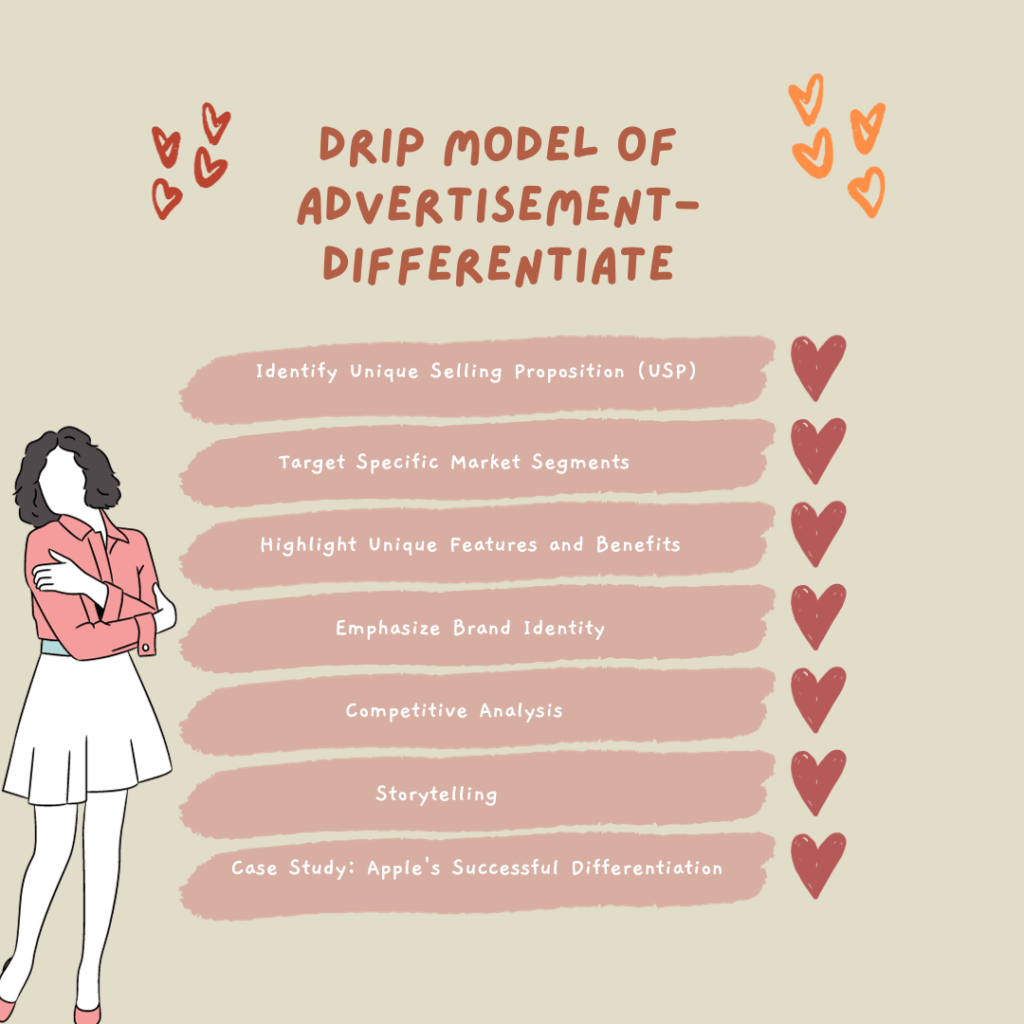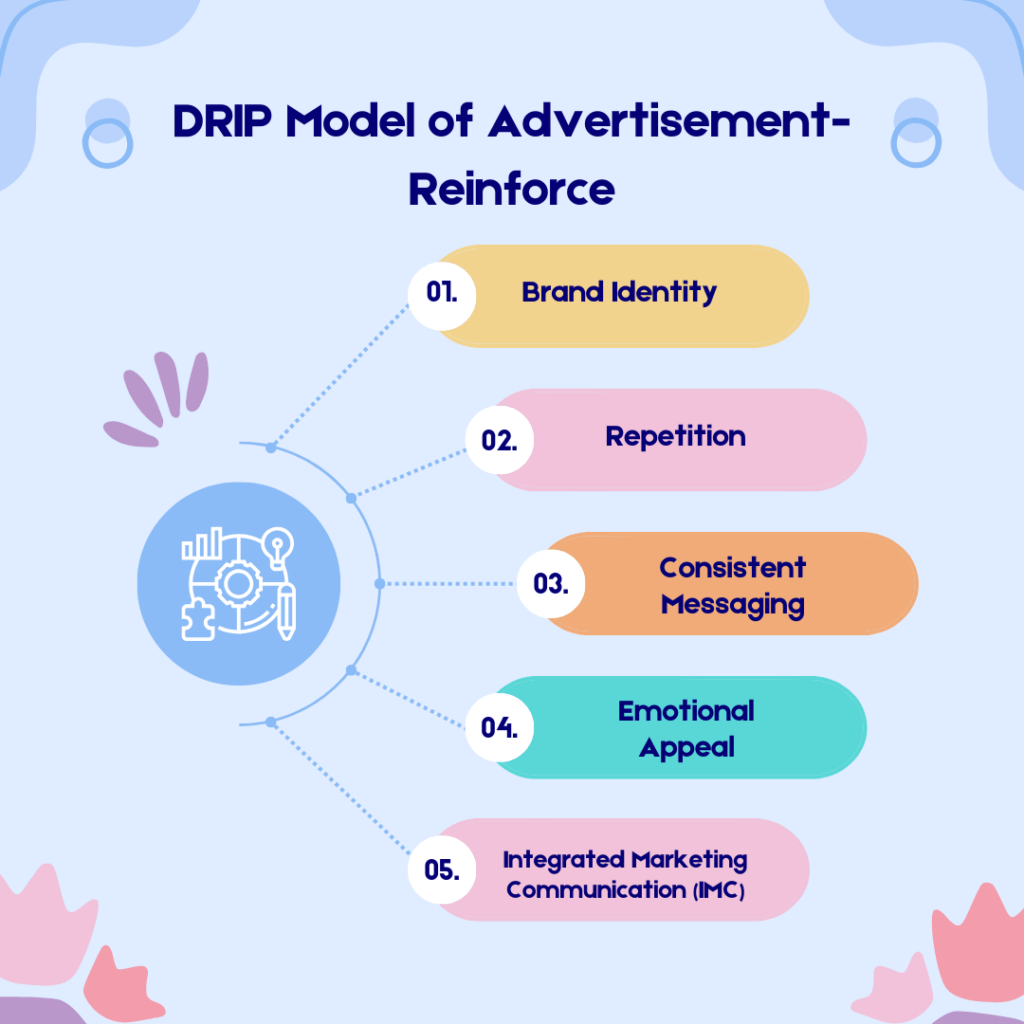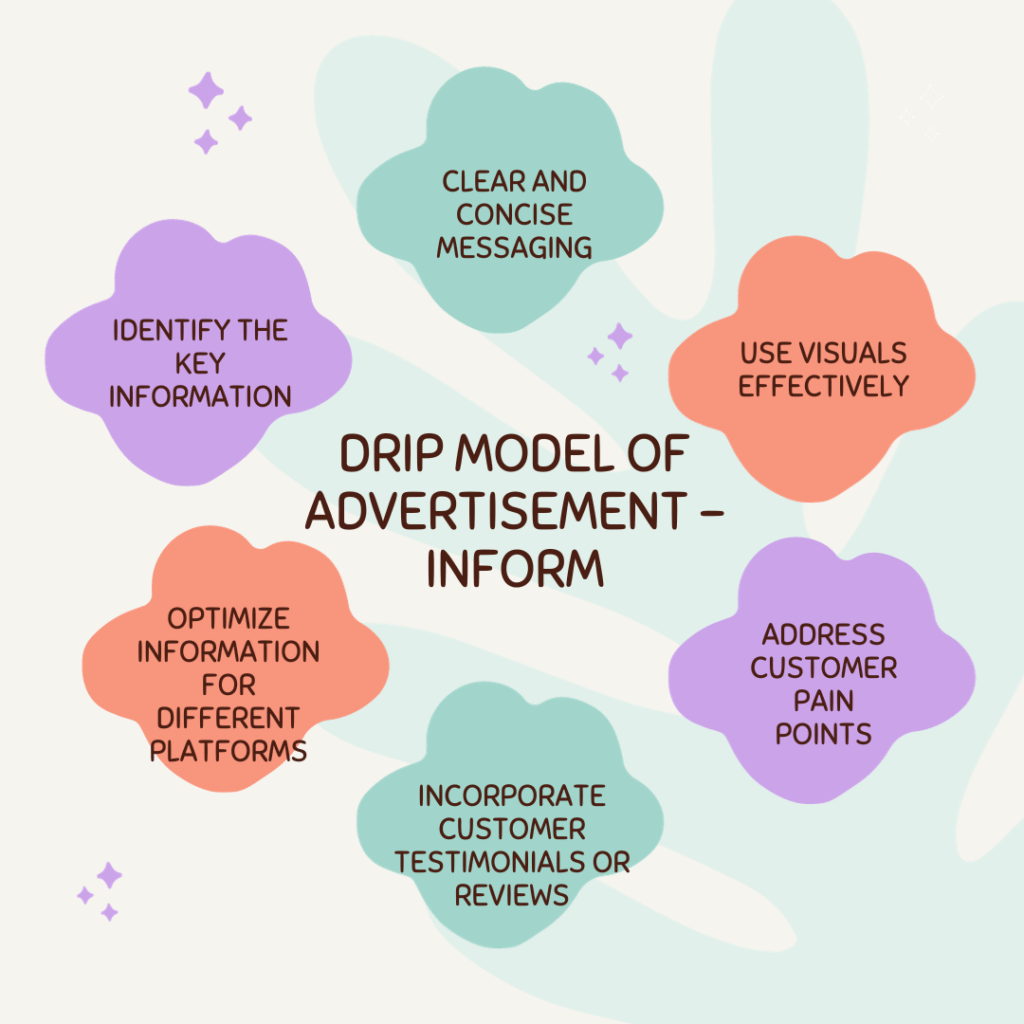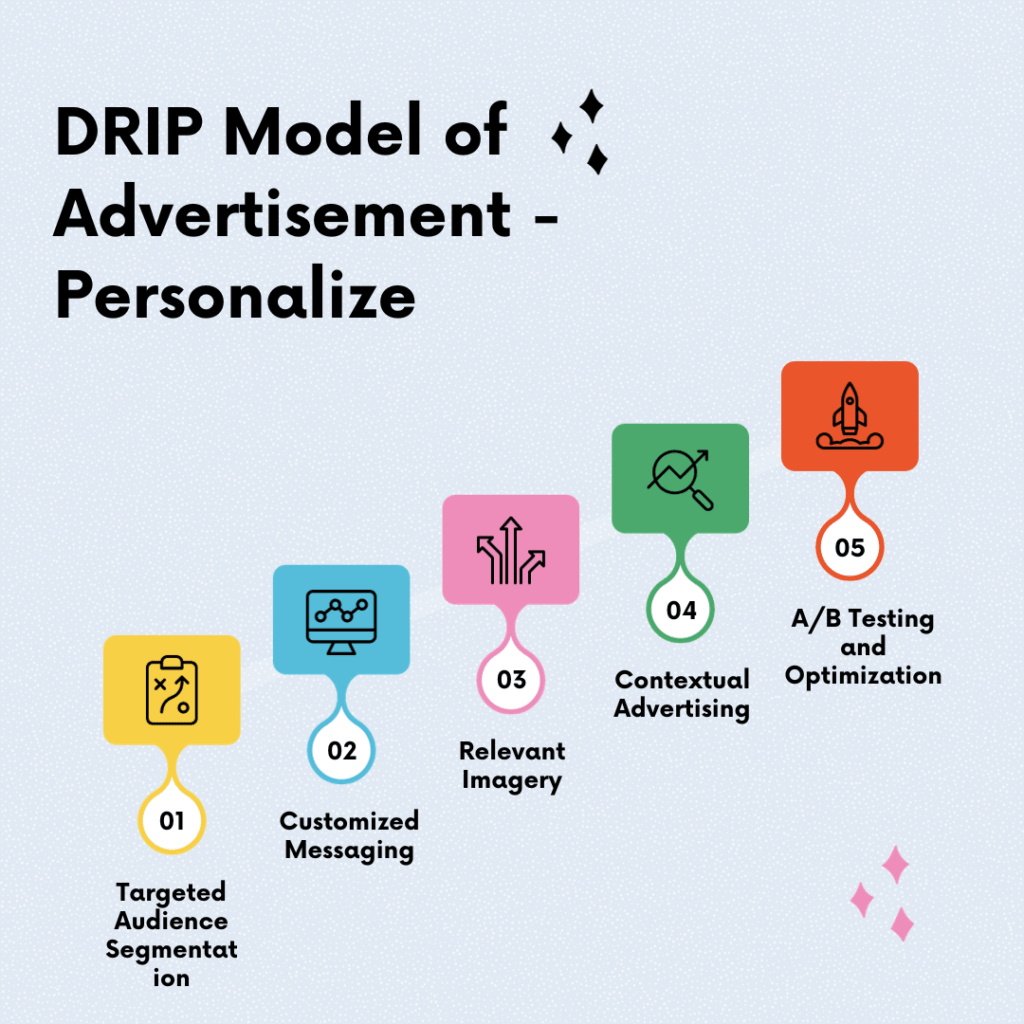DRIP Model: In today’s competitive business landscape, advertisement plays a crucial role in attracting customers and enhancing brand awareness. Traditional advertising models have evolved over time to meet the changing needs and preferences of consumers. One such model that has gained popularity is the DRIP model, which stands for Differentiate, Reinforce, Inform, and Personalize. This model focuses on creating effective and engaging advertisements that leave a lasting impression on the target audience. In this blog post, we will explore the DRIP model in detail and understand its impact on effective advertising.
DRIP Model of Advertisement
DRIP Model of Advertisement- Differentiate
The first element of the DRIP model is to differentiate the product or service being advertised. In a crowded market, it is essential to stand out from competitors and highlight the unique features and benefits of your offering. By identifying and emphasizing what sets your product apart, you can attract attention and generate interest among potential customers. This could include factors such as superior quality, innovative features, or exceptional customer service.
Read more About Advertisement Models in our comprehensive post
Key Elements of Differentiate

Identify Unique Selling Proposition (USP)
To differentiate your product or service, you need to identify your unique selling proposition (USP). What sets your offering apart from competitors? It could be a specific feature, superior quality, exceptional customer service, innovative technology, or a combination of factors that make your product or service unique. Understanding your USP is the first step in creating an effective advertisement that resonates with your target audience.
Target Specific Market Segments
Once you have identified your USP, it’s crucial to target specific market segments that can benefit the most from your product or service. By understanding your target audience’s needs, preferences, and pain points, you can tailor your advertising message to capture their attention effectively. This targeted approach allows you to differentiate your offering based on the specific needs of a particular group, making your advertisement more relevant and impactful.
Highlight Unique Features and Benefits
In your advertising efforts, it is essential to showcase the unique features and benefits that set your product or service apart from competitors. Whether it’s a time-saving feature, cost-effectiveness, sustainability, or convenience, emphasize the advantages your offering provides to customers. This helps create a compelling value proposition and positions your brand as the top choice among consumers.
Emphasize Brand Identity
Another aspect of differentiation is creating a strong brand identity. By developing a unique and recognizable brand, you can differentiate yourselves in the minds of consumers. This includes elements such as your brand’s logo, color scheme, tagline, and overall brand personality. Consistently incorporating these branding elements in your advertisements reinforces your brand’s unique identity and increases brand recognition.
Competitive Analysis
Conducting a thorough analysis of your competitors is essential to ensure effective differentiation. Identify what your competitors are offering, their strengths and weaknesses, and how they position themselves in the market. This analysis can help you identify gaps that your product or service can fill or potential areas where you can differentiate and excel.
Storytelling
An excellent way to differentiate your brand is through storytelling. Sharing your brand’s story, values, and mission allows consumers to connect with your brand on an emotional level. By crafting authentic and compelling stories, you can set yourself apart from competitors and create a unique brand experience.
Case Study: Apple’s Successful Differentiation
Apple is a prime example of a company that has achieved remarkable differentiation through its advertisements. They focus on highlighting the sleek design, user-friendly interface, and innovative features of their products. By emphasizing their unique approach to technology and positioning themselves as pioneers in the industry, Apple has been able to differentiate themselves effectively and build a loyal customer base.
Read more About Advertisement Models in our comprehensive post
DRIP Model of Advertisement- Reinforce
The second element of the DRIP model focuses on reinforcing the brand’s message and values consistently. Consistency is key when it comes to building a strong brand identity and maintaining customer loyalty. By consistently reinforcing the brand’s core message in all advertising efforts, you can create a sense of familiarity and trust among your target audience. This can be achieved through consistent branding elements, such as using the same logo, colors, and taglines across different platforms and advertisements.
Key Elements of Reinforce

Brand Identity
Reinforcing the brand’s identity is crucial in creating a lasting impression on consumers. It involves consistently presenting the brand’s values, personality, and visual elements across all advertisements. This includes using the same logo, brand colors, typography, and taglines to create a unified and recognizable brand identity. By reinforcing the brand’s identity, customers can easily identify the brand and build a connection with it.
Repetition
Repetition is a powerful reinforcement technique in advertising. By repeatedly exposing the target audience to the brand’s message, it becomes more ingrained in their minds. Repetition helps to create familiarity and increases the chance of the brand being remembered when making purchasing decisions. However, it is important to strike a balance between effective repetition and avoiding overexposure that may lead to a negative impact.
Consistent Messaging
Consistent messaging is a key aspect of reinforcement. The brand’s core message, positioning, and values should be communicated consistently across various advertising platforms, such as print, digital, and social media. This ensures that the target audience receives a consistent and coherent message, strengthening their understanding and perception of the brand. Any deviation from consistent messaging can dilute the brand’s impact and confuse the audience.
Emotional Appeal
The reinforcement element of the DRIP model can be enhanced through emotional appeal in advertising. Emotions play a significant role in creating memorable and impactful advertisements. By reinforcing the emotional connection with the brand, customers are more likely to develop a stronger bond and loyalty. Emotional appeals such as humor, nostalgia, or storytelling can create a lasting impact and reinforce the brand’s message in a more engaging way.
Integrated Marketing Communication (IMC)
Reinforcing the brand’s message is also dependent on utilizing integrated marketing communication techniques. IMC ensures that the brand communicates its message consistently across different media and marketing channels. This includes aligning advertising efforts with other communication tools such as public relations, sales promotions, events, and sponsorships. By creating a cohesive and unified brand experience, reinforcement becomes more effective and impactful.
A real-life example that demonstrates the power of reinforcement is Coca-Cola. Coca-Cola has consistently reinforced its brand message of happiness, togetherness, and refreshing enjoyment across various advertising campaigns. Their advertisements consistently feature their logo, red and white color scheme, and iconic contour bottle, reinforcing their brand identity. The repetition of their feel-good stories and jingles has a powerful reinforcing effect on consumers’ perception of the brand.
Reinforcement in advertising is a critical element in creating a strong and coherent brand. By consistently reinforcing the brand’s message, values, and identity, businesses can establish a lasting impact on customers and build meaningful relationships. Remember, strong reinforcement not only attracts customers but also ensures their continued loyalty and advocacy for the brand.
Read more About Advertisement Models in our comprehensive post
DRIP Model of Advertisement – Inform
The third element of the DRIP model is to inform the audience about the product or service being advertised. Consumers are more likely to engage with advertisements that provide them with valuable information or solve a problem they are facing. Therefore, it is crucial to include relevant details about the product, its features, benefits, and how it can address the needs of potential customers. Clear and concise messaging combined with engaging visuals can effectively inform and educate the target audience.
Key Elements of Inform

Identify the key information
To inform the audience effectively, it is crucial to identify and prioritize the essential information that will resonate with potential customers. This includes details about the product’s features, benefits, functionality, pricing, and any unique selling points. Researching and understanding the target market’s needs and preferences can help uncover the most relevant information to include in the advertisement.
Clear and concise messaging
When communicating information in advertisements, it is essential to keep the messaging clear and concise. Avoid overwhelming the audience with excessive information that may confuse or disengage them. Instead, focus on highlighting the most compelling and persuasive aspects of the product or service. Use language that is easily understandable by the target audience, avoiding jargon or complex terms that may alienate or confuse them.
Use visuals effectively
Visuals can be a powerful tool for conveying information and capturing the attention of the audience. Consider utilizing images, videos, or infographics that demonstrate the product’s features or show real-life examples of how it can be used. Visual representations can help potential customers better understand the value and benefits of the product, making it more memorable and engaging.
Address customer pain points
Effective information in advertisements should address the pain points or problems that the target audience may have. By highlighting how the product or service can provide a solution or address specific needs, you can make a compelling case for consumers to consider your offering. Understanding your target audience’s challenges and positioning your product as a solution can greatly enhance the effectiveness of your advertisement.
Incorporate customer testimonials or reviews
Including customer testimonials or reviews in your advertisements can add credibility and further inform the audience about the positive experiences of others. People often rely on social proof when making purchasing decisions, and showcasing positive feedback can instill confidence and trust in your product. Real-life testimonials can provide valuable information in a relatable and authentic manner.
Optimize information for different platforms
In today’s digital age, advertisements are often delivered across various platforms and devices. It is crucial to optimize the information for each platform to ensure it is easily accessible and digestible. Consider the limitations of different channels, such as character limits on social media platforms or mobile screen sizes, and adapt your information accordingly. This will ensure that the audience receives the necessary details, regardless of the platform they encounter your advertisement.
Incorporating informative elements into your advertisements not only educates the audience about your product or service but also helps establish your brand as an authority in the industry. By providing valuable information, you can build trust, address customer concerns, and guide potential customers towards making informed purchasing decisions.
Remember, the key is to strike a balance between being informative and engaging. Creating compelling and visually appealing advertisements that effectively communicate the necessary information will captivate your audience and increase the likelihood of driving conversions and sales.
Want to learn about more advertisement models, Read on
DRIP Model of Advertisement – Personalize
The final element of the DRIP model is to personalize the advertisement to make it more relatable and targeted to the specific audience. Personalization involves tailoring the marketing message and visuals to resonate with the interests, preferences, and demographics of the target audience. This could be achieved through using language and imagery that appeals to a specific age group, gender, or lifestyle. Personalization creates a sense of connection and makes the advertisement more memorable for the audience.
Personalization in advertising is all about tailoring your message and visuals to resonate with your target audience on a deeper level. By understanding their interests, preferences, demographics, and behaviors, you can create advertisements that feel more relevant and relatable. Here are a few key aspects to consider when implementing personalization in your advertising efforts:
Key Elements of Personalize

Targeted Audience Segmentation
To effectively personalize your advertisements, it is essential to divide your target audience into segments based on common characteristics. These characteristics can include demographics (age, gender, location), psychographics (values, beliefs, interests), or behaviors (purchasing habits, online activities). By breaking down your audience into specific segments, you can create tailored messages that speak directly to their needs and preferences.
Customized Messaging
Once you have identified your target segments, it’s time to craft messages that resonate with each group. Personalized messaging goes beyond simply using the recipient’s name in the advertisement. It involves understanding their pain points, desires, and aspirations and addressing them directly through your messaging. Tailor the language, tone, and style of your copy to match the preferences of each segment. For example, if your target audience consists of young millennials, you might use informal and playful language, while a more formal tone could resonate better with a corporate audience.
Relevant Imagery
In addition to personalized messaging, selecting images and visuals that align with your target audience’s interests and preferences can enhance the impact of your advertisement. Use images that your audience can relate to and that reflect their lifestyle, aspirations, or desires. For example, if you are targeting outdoor enthusiasts, showcasing images of people hiking, camping, or enjoying nature can be highly effective.
Contextual Advertising
Contextual advertising involves delivering personalized ads that are relevant to the user’s current activity or interests. This approach leverages data to understand the user’s online behavior and displays ads that align with their browsing history, recent searches, or previous purchases. For example, if a user has been browsing for running shoes, displaying an ad for a discounted pair of running shoes can grab their attention and increase the likelihood of conversion.
A/B Testing and Optimization
To ensure the effectiveness of your personalized advertisements, it is essential to conduct A/B testing. Test different messages, visuals, and calls to action to determine which combination resonates best with each segment. Continuously monitor and analyze the results to refine your approach and optimize your campaigns. This iterative process allows you to improve the performance of your personalized advertisements over time.
Personalization in advertising is a powerful strategy that can significantly impact consumer engagement, response rates, and ultimately, conversion rates. When executed effectively, it creates a sense of connection and relevance, making your advertisements more memorable and influential.
Remember that personalization should always be based on ethical and transparent data practices. Strive to provide value to your audience while respecting their privacy and preferences. By applying the personalization element of the DRIP model in your advertising efforts, you can create compelling and highly targeted campaigns that resonate with your audience and generate better results.
Want to learn about more advertisement models, Read on
Case Study: The Success of Amazon’s through DRIP Model
To understand the impact of the DRIP model in practice, let’s look at Amazon’s advertising strategy. Amazon effectively utilizes the model by differentiating itself as the go-to online shopping platform with a vast selection, fast delivery, and competitive prices. They reinforce their brand message consistently across different channels, creating a sense of reliability and trust. Through their advertisements, they inform customers about product features, benefits, and user reviews. Lastly, Amazon uses personalization techniques, such as recommending products based on past purchases or browsing history, to enhance the customer experience
Samrat is a Delhi-based MBA from the Indian Institute of Management. He is a Strategy, AI, and Marketing Enthusiast and passionately writes about core and emerging topics in Management studies. Reach out to his LinkedIn for a discussion or follow his Quora Page

